Broadcast Sport spent two days with World Athletics Productions at the National Athletics Centre in Budapest

It’s fair to say Budapest was totally taken over by the World Athletics Championships last month. The moment you land in the city, it’s abundantly clear it has really got behind the event.
World Athletics Championships branding is prominently plastered across the airport and en route into the city centre, and taxi drivers talk enthusiastically about the impact hosting such a prestigious event will have on the city.
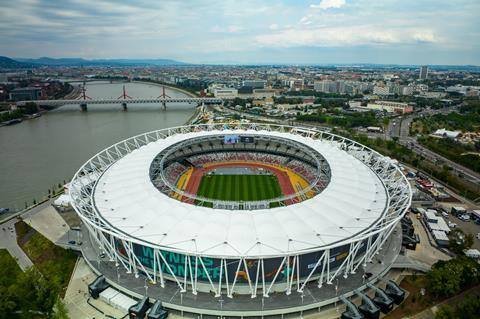
It’s the largest sporting event Hungary has ever hosted with athletes from more than 200 countries taking part. It involved Hungary constructing the beautifully located 35,000 seater National Athletics Centre on the eastern bank of the Danube River, which became the centrepiece of the event.
The Hungarian public were just as enthusiastic, with seven out of the nine evenings of the World Championships taking place in a sold-out stadium. Sixty percent of the attendees were from Hungary, too.
Broadcast Sport spent several days at the World Athletics Championships, after being invited over by World Athletics Productions (the joint venture between World Athletics and ITN to host broadcast World Athletics events) to tour behind-the-scenes and talk to the production team about the challenges of staging such a large-scale event.
The team is headed up by Alastair Waddington, director of sport at ITN and managing director of World Athletics Productions. Broadcast Sport sat down in his heavily airconditioned porta cabin office in the production compound, just next to the National Athletics Centre.
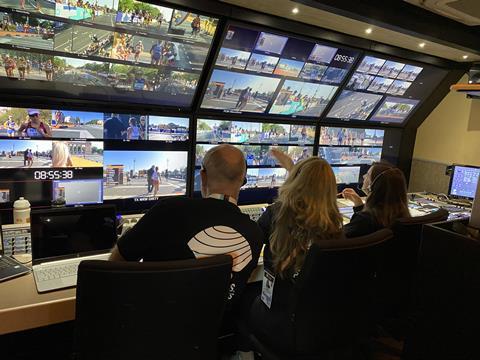
Huge scale event
The compound is huge, housing nine galleries covering a multiple of different athletics events taking place at any one time in the stadium, as well as the marathon and marathon walks in Budapest city centre.
Work began on preparing for the setup of the production area more than a year ago, when Waddington and his team sat in front of all the rights holders and laid out their production plans, complete with details on the cable runs and the different options available for rights holders to book.
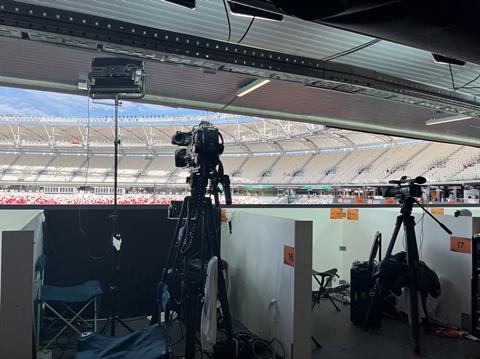
“We run all the cables into the stadium for them otherwise it’s chaos, so when the rig starts, we know we’re rigging 50 cables for the host broadcast, along with all these other cables for different rights holders,” says Waddington.
This host broadcaster-led approach extends to the vast majority of the camera positions too, which are installed and operated by World Athletics Productions. “The old days of the host broadcaster just putting half a dozen cameras up and shooting everything wide and then leaving it to the rights holders to do their add-ons are a thing of the past,” says Waddington.

Camera Innovations
There are a number of significant innovations in the camera setup for the World Athletics Championships in Budapest, most notably a 1km wirecam that stretches along the route of the marathon walk.
ITN head of technical production Jenny King joined us in Waddington’s office to tell Broadcast Sport more about it. “The 1km wirecam runs from the top of Hero Square all the way down. The marathon race walk is in a beautiful area of Budapest and it’s elements like that which are really enhancing the coverage.
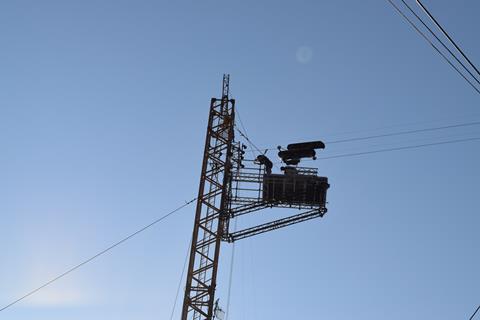
The wirecam has an 80-metre truss at either end and dips to a lowest point in the middle of 50 metres. Six tonnes of ballast is needed at either end to keep it up. The camera on the wirecam has a 40-to-1 stabilised lens on it so is able to capture beautiful images looking down over the top of the athletes as they come around Hero Square.

“As the athletes come round Hero Square, we also have a specially designed camera on a gimbal which sits on the back of a buggy to get some really nice angles of the athletes, and you can really see the architecture of Hero Square and that’s been really nice,” continues King. “We decided against using any helicopters for this for sustainability reasons, so we’ve got a drone in action for the marathon too, and when it’s not in use there we bring it over to the stadium.”
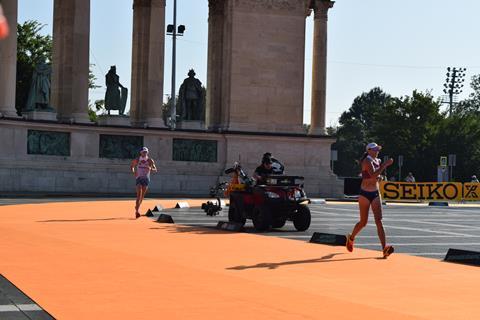
King adds: “And then within the stadium itself we’ve got a few more wirecams – there’s quite a long one running right across the top of the stadium and then we’ve got one along the back straight and the home straight. We’ve also introduced a wirecam for the horizonal jumps that’s super slow mo so you really see the speed of the athletes.
“We’ve also got railcams – again, one on the home straight and one on the back straight. Normally, you would only have the railcams, so putting in the wirecams has given that extra depth to the coverage.”
Buggy cams are also used to film athletes’ arrivals to the stadium, tracking them for nearly half a mile along the route, allowing interviews to take place a little in advance of the athletes competing in their events.

Outside broadcast
The outside broadcast of the World Athletics Championships is being handled by NEP, which utilised flypacks to supply all the galleries. The flypacks are put together in NEP’s base in Bracknell, transported over to Budapest and unpacked into a network of production buildings within the compound.
The trucks left Bracknell on 30 July, and unpacking began on 5 August, ahead of the Championships starting on 19 August.
Meanwhile, NEP Germany covered the road races, with German trucks and a German crew based at Hero Square.
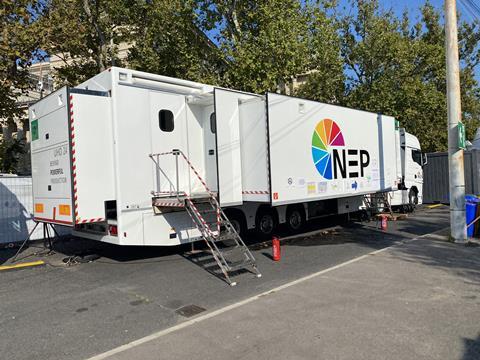
The live coverage from all the galleries across all events feeds into a separate integrated gallery, which becomes the world feed gallery for the plethora of rights holders broadcasting the content.
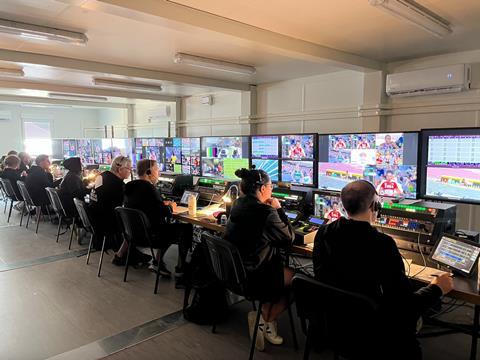
“Athletics is a complicated sport,” sums up Waddington. “There is a lot going on in the stadium at the same time, and the timetable dictates how many galleries we need. During the decathlon or the heptathlon, there might be a whole bunch of things going on while the main events are also happening on the track, which is why we have so many control rooms.”
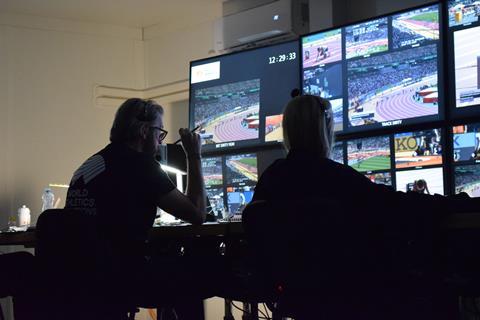
Each control room has its own team dedicated to that specific event, made up of a producer, PAs, director, vision mixer and EVS operators – and they operate as a team, eat and drink as a team and all stay in the same hotel.
The number of people working at the compound is signifcant, given the scale of the event, with more than 400 people in different roles. Approximately half are engineers of some description – computer programmers, TV engineers, sound assistants and so on – while a large number are in operational roles, serving rights holders, running the bookings office, working as information officers, etc.
The information office sends 5 to 10 updates to rights holders throughout the day, sharing timetable changes, anything technical that they need to know, running orders and so on.
The World Athletics Championships on the BBC
Broadcast Sport talks to Matt Griffiths, lead director for the BBC

“We’re doing what we like to call Integrated Plus. We’ve basically taken the integrated feed, adding in bits that we might have missed when we come away to do stuff in the studio.
We’re trying to make it look as bespoke as possible. We’re here because we want to get across to people at home the energy and excitement. What it’s like to actually be at a big event. That’s why we come out here en masse.
The atmosphere out there is brilliant. We could have done it in a greenscreen studio back in Salford but you just wouldn’t get that atmosphere. You wouldn’t get that live feel that you get when you’re actually at an event. It’s such a crazy big event, we just have to be here.
To be able to be at one of these big events is a privilege, and even more so in this day and age (of remote production).
We’ve got a nice studio position at the end of the 100 metre straight, which is good. Red Button are taking in direct feeds for the marathon and the race walks and we’re adding our own commentary on the marathons, but we’re just taking the world feed for the race walks.
The weather caused a few issues on the first couple of days – nobody expected that torrential rain – and our truck is really struggling with the heat actually. We’ve had to spray down our air conditioning units every 5 minutes as it’s so hot. We measured it at about 50 degrees at one point.
We’ve got two of our own ISO cameras – a head-on on the home straight and one at the 200 metres start, so we can do our own close-ups and little bits of our own coverage of some of the field events when people aren’t being covered. For example, Holly Bradshaw didn’t make the integrated feed but with our own cameras we were able to cover some of her jumps, which was good.”
A new direction
A big focus of World Athletics Productions, in terms of staffing for creative roles, has been in bringing in live directors that are new to athletics, to bring a fresh eye and a renewed pace to proceedings. A good example of this is the introduction of Formula 1 and Formula E live director West Gillet to direct the track events.
“He’s a specialist in people going round and round in circles quickly, so he’s really good with movement, and is used to having to make decisions really quickly,” explains Waddington. “We felt athletics had been covered very similarly for many years and we wanted to do things a little differently and build the connection between the athletes and the audience.” However, Waddington adds: “Athletics is a very traditional sport and there’s lots of things you have to do in a traditional way because there are sixty commentary boxes waiting for athletics to be produced in a certain way. After the finish line, they are expecting certain replays in a certain order, for example. The challenge in taking that forwards is you’ve got to preserve everything that’s good about the past but also introduce something new.”
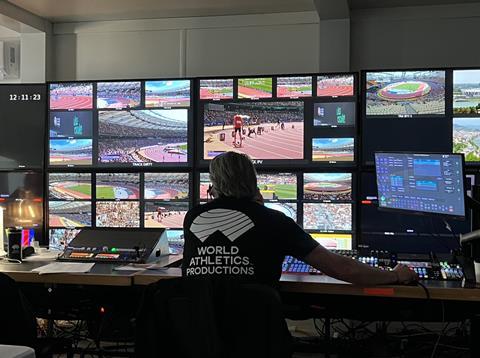
Leading up to the World Athletics Championships, Mark Fulton, executive producer of World Athletics Productions, works closely with all the sports directors to ensure they know the fundamentals of how to cover athletics, while also encouraging the directors to push the boundaries and try new things.
Fulton joined us in Waddington’s office to explain the process. “The first thing to say is that they’re all phenomenally experienced directors and bring in a wealth of knowledge from everything from football, cricket, tennis, and a lot of different sports,” says Fulton.

“Before the World Athletics Championships, we went through the whole intricacies of what we expected, and they’ve gone away and watched past Championships and have come back with a number of suggestions – What if we try this? What if we try that? – which has helped us try to change the way the sport is perceived broadcast-wise.”
Fulton adds that, as well as looking for sports directors from outside of athletics, they also worked hard to try to create more gender balance. “We wanted to put women into high profile positions, so we looked for female sports directors that weren’t necessarily getting the breaks they would want.”
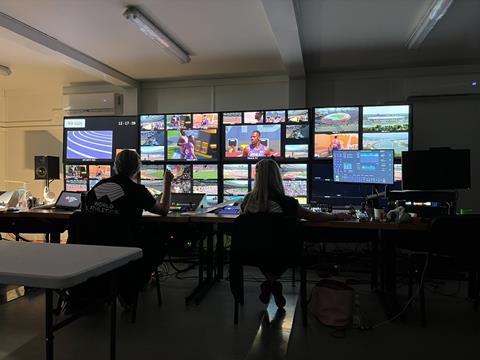
He singles out Clair Goodwin, the director of the marathon race walks, as an example. She vision mixed the BBC’s athletics for a long time and started working with World Athletics on the World Indoors and has proved herself invaluable in what World Athletics Productions is aiming to achieve.
Fulton said: “We said to Clair, ‘Right, you understand the sport, come in and have a go’. And she came in and did a phenomenal job. I would say she’s one of the best female athletics directors in the world, by far. Her attention to detail is really, really good.”
Asked if these changes in directing the different sports of the World Athletics Championships have gone down well with rights holders, Fulton says: “Athletics is a funny sport because it’s steeped in tradition and when we try and change something, it doesn’t necessarily sit well with certain people. I’ve been involved in athletics since the mid-eighties, and up until maybe five or six years ago the template for athletics production has been the same.
“So, when you come in and try to change that template you almost get a, ‘What are you trying to do here?’ response. But then the penny drops and they suddenly realise, ‘Right, now I get it.’ The sport had to change.”
In Waddington’s view, “Broadcasters get the development and the evolution. They’re on the journey with us, and the feedback from broadcasters generally has been fantastic.”
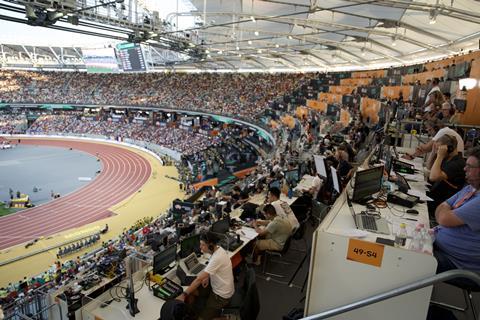
Digital Media Hub
Another innovation World Athletics Productions have brought to the event is creating a constantly updated Digital Media Hub. This repository of content is something rights holders can dip into and take what they like whenever they like. It includes openers, closers, fast turnaround highlights, interviews and more.
Broadcasters use it for social as well as on air content – the BBC, for example, ran several of the openers on there. The Digital Media Hub is complemented by the ‘Rolling Content Feed’, which is a live feed, like a gallery feed, continually available as the events unfold.
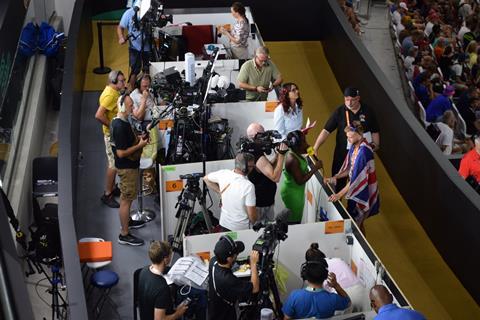
AI experimentation
Sticking with innovation, World Athletics Productions used the Championships to experiment with AI.
It used AI to create seven language versions of news bulletins issued several times a day, utilising four AI tools – a transcription tool, a translation tool, a voice tool, and an edit tool.
It results in the same voice speaking seven languages, including four European languages and Hindi.

The focus is on using AI for practical reasons rather than purely just for the sake of it, explains Waddington. “That’s the kind of likely place for AI as we see it, allowing us to do more for less. The content we’ve created with AI is very strictly labelled so the broadcasters know what they’re getting – a script that’s been written by AI and a voiceover that’s been done by AI.”
King, who is looking after the AI experiment, adds: “It’s a proof of concept using AI, and it’s very useful for rights holders to be able to access as it will obviously save them in having to commentate themselves on that package.
“We’re doing it for the news feed distributed on the Digital Media Hub, just to see if it will work, and I think we’d need to have a look and see how successful it’s been. It’s just a really interesting bit of work we’ve done on the side.”
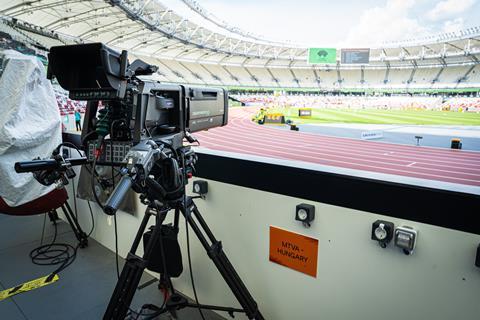
Doing a Drive To Survive
Inevitably, given the success of Drive To Survive in widening the appeal of F1, there is a documentary team shooting content from the World Athletics Championships for a future Netflix documentary. Almost as inevitably, the team is from Drive To Survive maker Box To Box.
Broadcast Sport spoke to World Athletics director of broadcasting James Lord about the need for athletics to tell stories from on and off the track. He said: “Maintaining a good, strong level of interest throughout the season is very important – to have the opportunity to distribute content on a platform like Netflix globally, to tell a story that we don’t currently tell, because it’s behind the scenes and everything else, actually that’s really quite exciting.”








1 Readers' comment